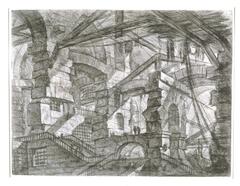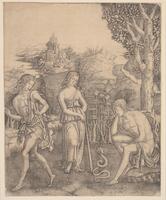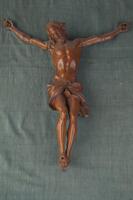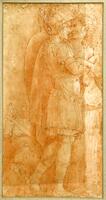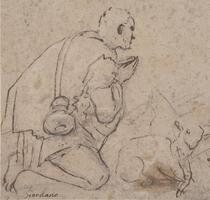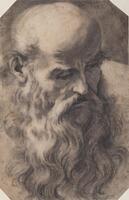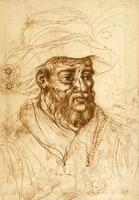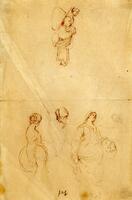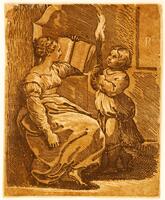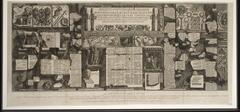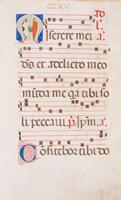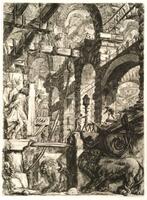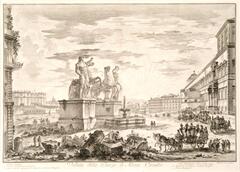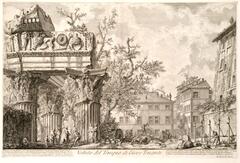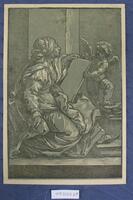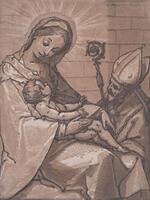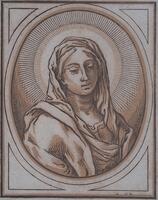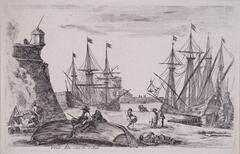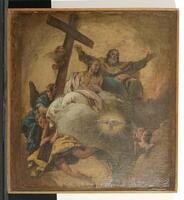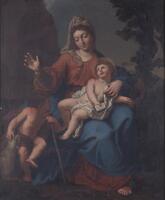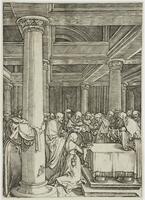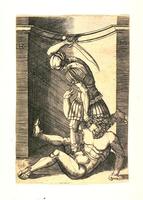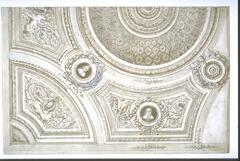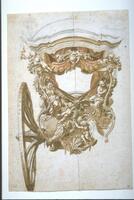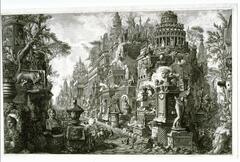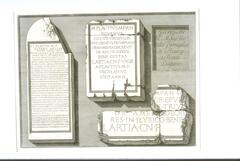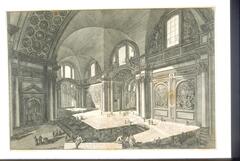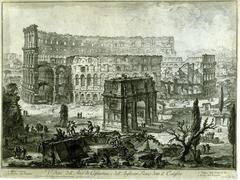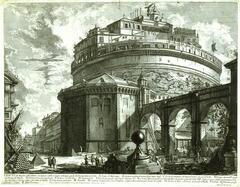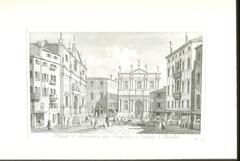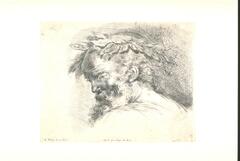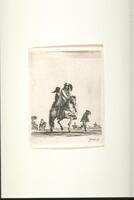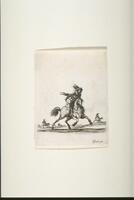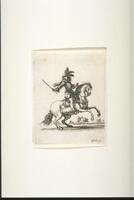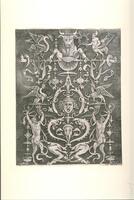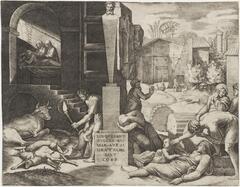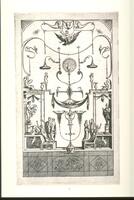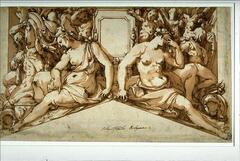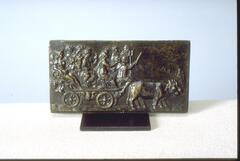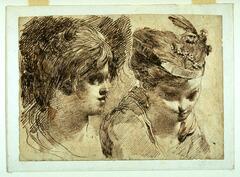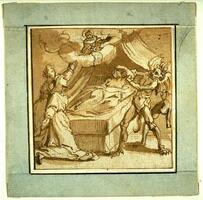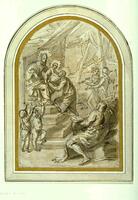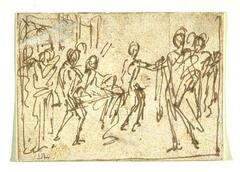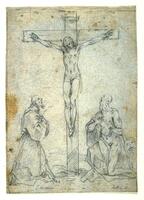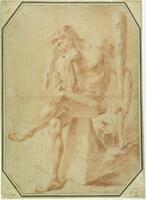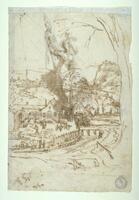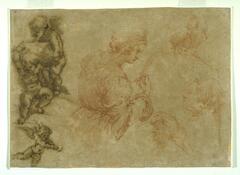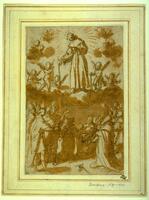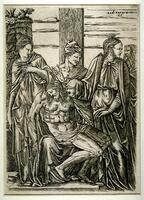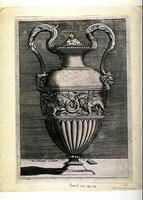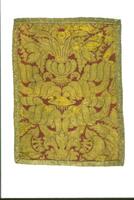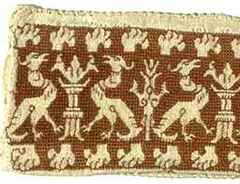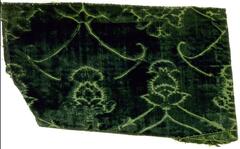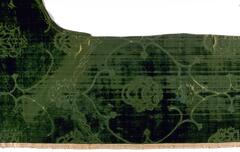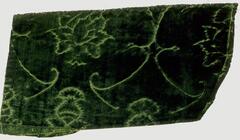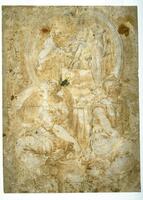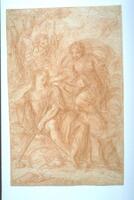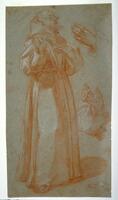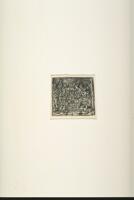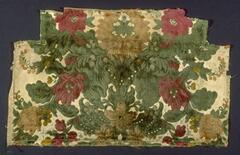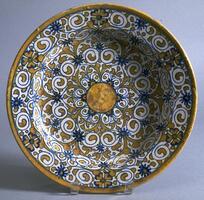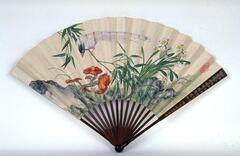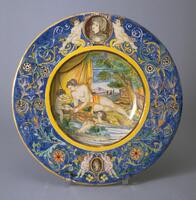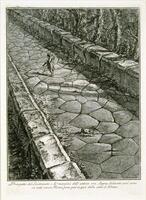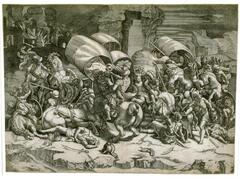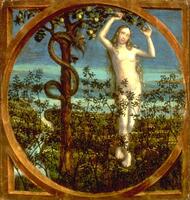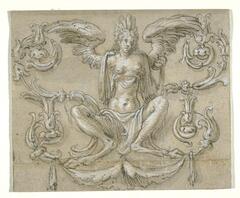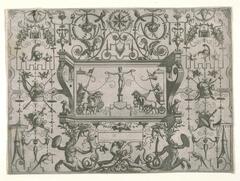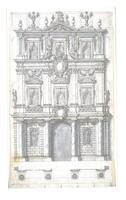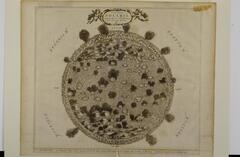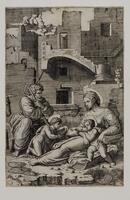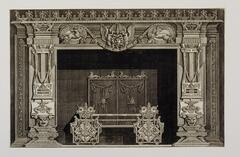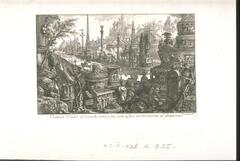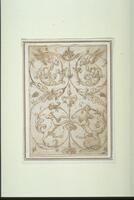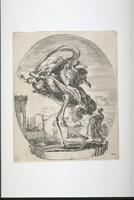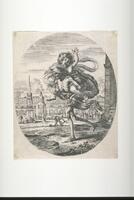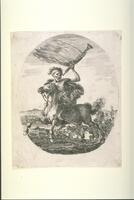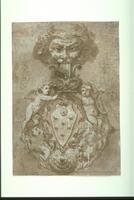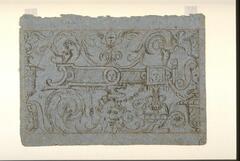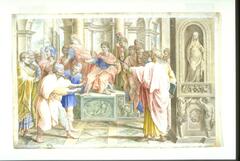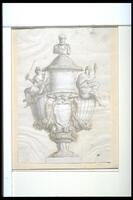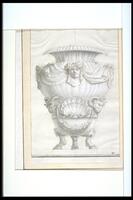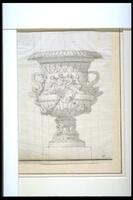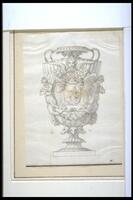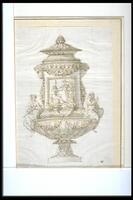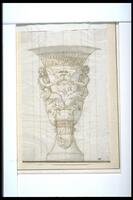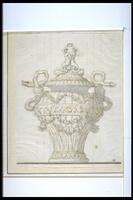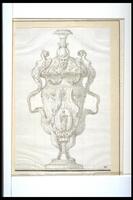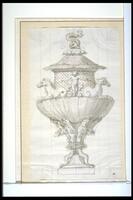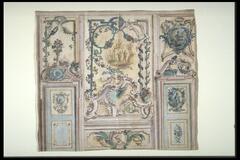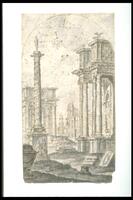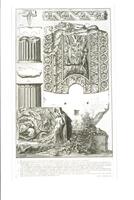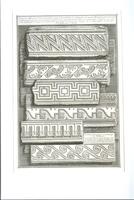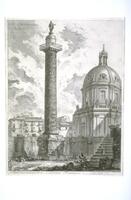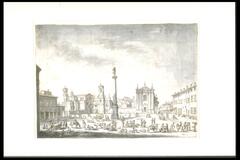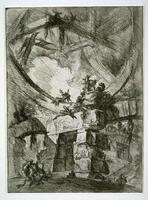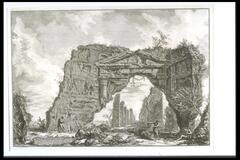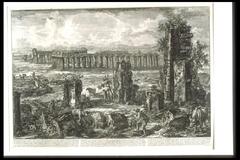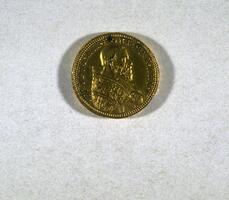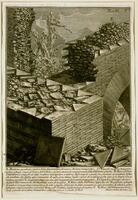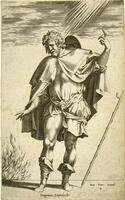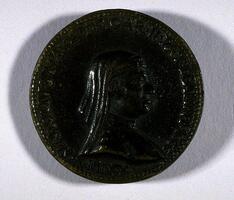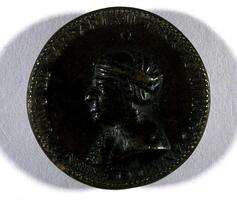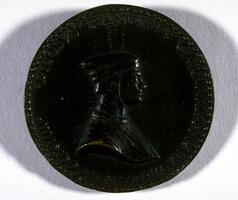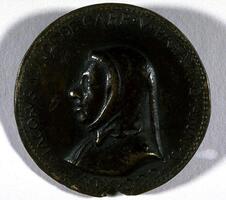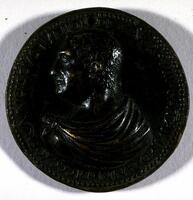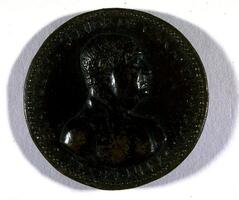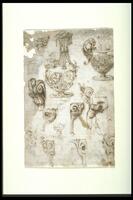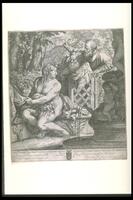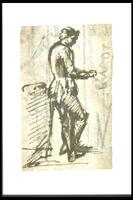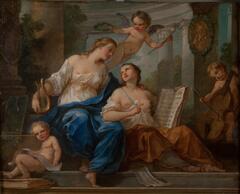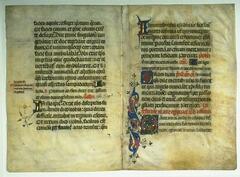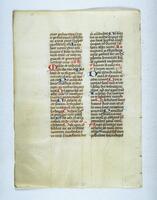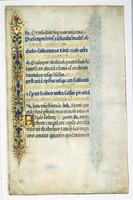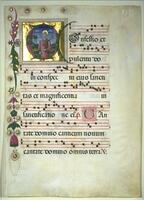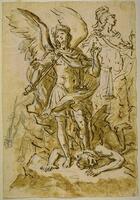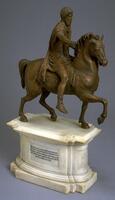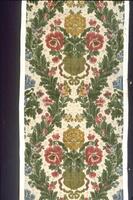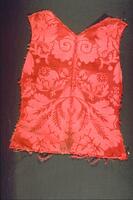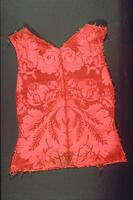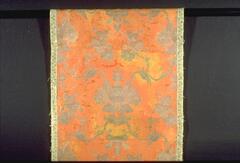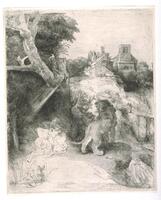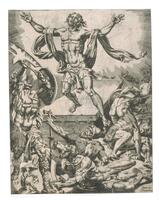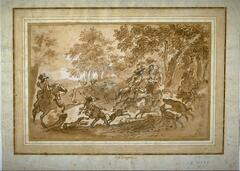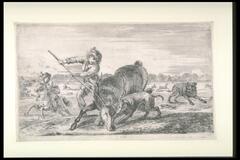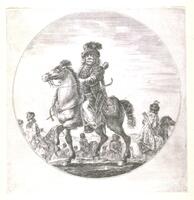14 Items in this Learning Collection
Collection Object
Collection Object
Collection Object
Collection Object
Collection Object
Collection Object
Collection Object
Collection Object
Collection Object
Collection Object
Collection Object
Collection Object
Copyright
All Rights Reserved
()
Battle of the Sea Gods
Accession Number
1996/2.1
Title
Battle of the Sea Gods
Artist(s)
Daniel Hopfer
Object Creation Date
early 16th century
Medium & Support
etching on iron on medium, slightly textured light beige laid paper
Dimensions
6 1/4 in. x 9 1/16 in. ( 15.8 cm x 23.02 cm )
Credit Line
Museum Purchase
Label copy
Gallery Rotation Spring/Summer 2012
Daniel Hopfer
Germany, circa 1470–1536
Battle of the Sea Gods
Early 16th century
Etching on iron
Museum purchase, 1996/2.1
In ancient mythology Neptune (Poseidon) ruled the sea and was second only to his brother Jupiter among the gods of Olympus. He is identified in the visual arts by his three-pronged trident, which allowed him to shake and shatter whatever he pleased. Here Neptune is seen from behind in the back of the composition, perhaps in the form of a sculpture. In the front, fantastical creatures emerge from the water carrying nude male figures crowned and brandishing fish—presumably sea gods. The female figure in the upper left corner is a representation of Envy. The composition and this detail are based on a section of a famous painting by Andrea Mantegna (Italian, 1431–1506), itself inspired by mythological scenes from ancient Roman relief sculpture.
Hopfer, who was trained as an etcher of armor, is believed to have invented the process of etching on iron plates to make prints. While engraving requires only the use of a specialized tool to carve lines directly into a metal plate, in etching a needle is used to draw in a waxy, acid-resistant coating, exposing the metal beneath, and acid is then used to “bite” the design into the plate. Partly because of the fluid translation of drawing into etching, it went on to become the method of choice for many Early Renaissance printmakers.
Subject matter
Daniel Hopfer was a 16th c. German etcher who was first trained as an armor maker and used thin iron plates for his prints - a process he invented. This print depicts one part of a larger composition by the sixteenth-century Northern Italian painter Andrea Mantegna (1430/31–1506), itself based on the relief (shallow) carving decorating a Roman sarcophagus. Mantegna frequently made reference to Roman relief sculpture in his work and his designs in turn inspired the work of engravers, whose prints provided a wider dissemination of his art. This image, in which nude figures astride fantastical creatures dominate, has been interpreted as an allegory on the theme of envy. This impression once belonged to the British painter Sir Thomas Lawrence (1769–1830), whose collector’s mark is visible at the lower left corner.
Physical Description
This black and white print depicts an animated and detailed scene of nude figures and mythical beasts on the surface of the sea.Two men, with seaweed hair and riding half horse/half fish creatures, strike out at each other. A man and a woman ride a beast with a scaly body and the head of a fierce dog. In the background, a man holding a trident stands with his back to the viewer. Action and motion are expressed with billowing drapery, flowing hair and moving waves. The wide mouthed expressions of the figures and animals suggest yelling and noise in this chaotic scene. Among the many details depicted by the artist is a plaque held by the woman that has his initials.
Primary Object Classification
Print
Primary Object Type
intaglio print
Additional Object Classification(s)
Print
Collection Area
Western
Rights
If you are interested in using an image for a publication, please visit http://umma.umich.edu/request-image for more information and to fill out the online Image Rights and Reproductions Request Form.
Keywords
battles
etching (printing process)
gods (dieties)
horses (equipment)
seas
1996/2.1
Title
Battle of the Sea Gods
Artist(s)
Daniel Hopfer
Object Creation Date
early 16th century
Medium & Support
etching on iron on medium, slightly textured light beige laid paper
Dimensions
6 1/4 in. x 9 1/16 in. ( 15.8 cm x 23.02 cm )
Credit Line
Museum Purchase
Label copy
Gallery Rotation Spring/Summer 2012
Daniel Hopfer
Germany, circa 1470–1536
Battle of the Sea Gods
Early 16th century
Etching on iron
Museum purchase, 1996/2.1
In ancient mythology Neptune (Poseidon) ruled the sea and was second only to his brother Jupiter among the gods of Olympus. He is identified in the visual arts by his three-pronged trident, which allowed him to shake and shatter whatever he pleased. Here Neptune is seen from behind in the back of the composition, perhaps in the form of a sculpture. In the front, fantastical creatures emerge from the water carrying nude male figures crowned and brandishing fish—presumably sea gods. The female figure in the upper left corner is a representation of Envy. The composition and this detail are based on a section of a famous painting by Andrea Mantegna (Italian, 1431–1506), itself inspired by mythological scenes from ancient Roman relief sculpture.
Hopfer, who was trained as an etcher of armor, is believed to have invented the process of etching on iron plates to make prints. While engraving requires only the use of a specialized tool to carve lines directly into a metal plate, in etching a needle is used to draw in a waxy, acid-resistant coating, exposing the metal beneath, and acid is then used to “bite” the design into the plate. Partly because of the fluid translation of drawing into etching, it went on to become the method of choice for many Early Renaissance printmakers.
Subject matter
Daniel Hopfer was a 16th c. German etcher who was first trained as an armor maker and used thin iron plates for his prints - a process he invented. This print depicts one part of a larger composition by the sixteenth-century Northern Italian painter Andrea Mantegna (1430/31–1506), itself based on the relief (shallow) carving decorating a Roman sarcophagus. Mantegna frequently made reference to Roman relief sculpture in his work and his designs in turn inspired the work of engravers, whose prints provided a wider dissemination of his art. This image, in which nude figures astride fantastical creatures dominate, has been interpreted as an allegory on the theme of envy. This impression once belonged to the British painter Sir Thomas Lawrence (1769–1830), whose collector’s mark is visible at the lower left corner.
Physical Description
This black and white print depicts an animated and detailed scene of nude figures and mythical beasts on the surface of the sea.Two men, with seaweed hair and riding half horse/half fish creatures, strike out at each other. A man and a woman ride a beast with a scaly body and the head of a fierce dog. In the background, a man holding a trident stands with his back to the viewer. Action and motion are expressed with billowing drapery, flowing hair and moving waves. The wide mouthed expressions of the figures and animals suggest yelling and noise in this chaotic scene. Among the many details depicted by the artist is a plaque held by the woman that has his initials.
Primary Object Classification
Primary Object Type
intaglio print
Additional Object Classification(s)
Collection Area
Western
Rights
If you are interested in using an image for a publication, please visit http://umma.umich.edu/request-image for more information and to fill out the online Image Rights and Reproductions Request Form.
Keywords
battles
etching (printing process)
gods (dieties)
horses (equipment)
seas


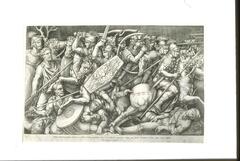
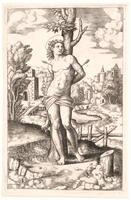
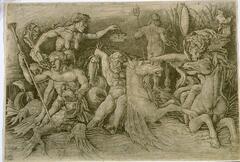
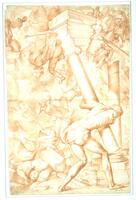
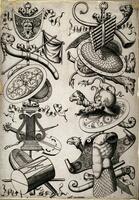



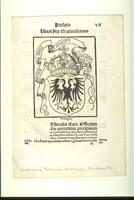
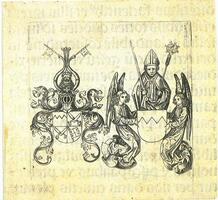


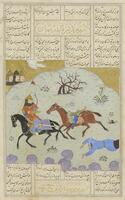
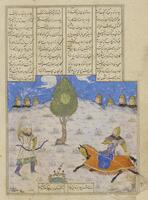
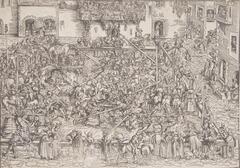
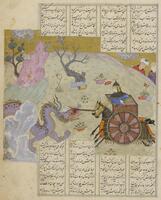

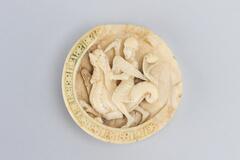
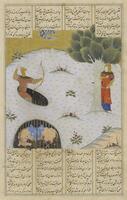
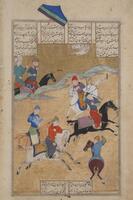
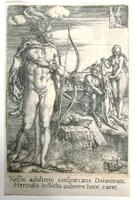
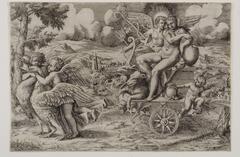
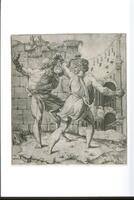
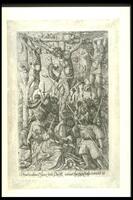



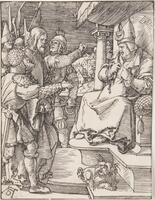
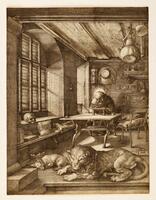



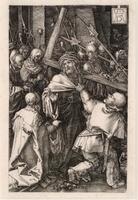
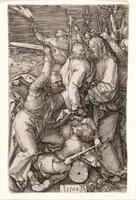
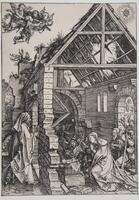
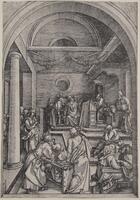
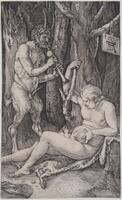
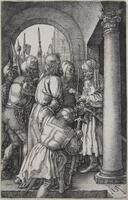
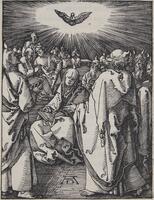
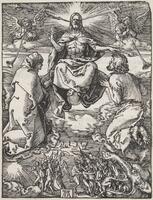

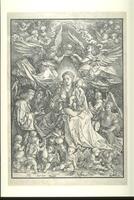
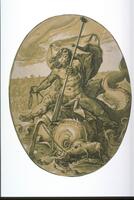


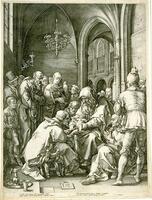
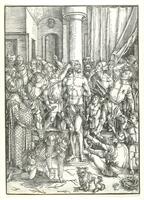
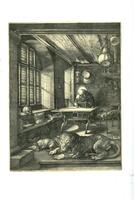
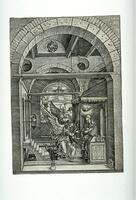
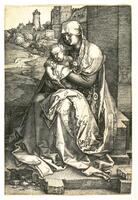

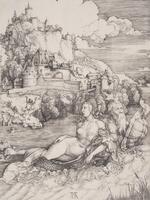
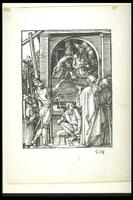
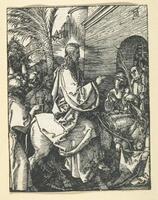
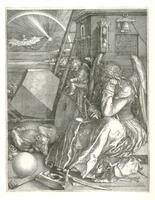



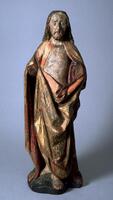
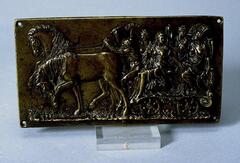

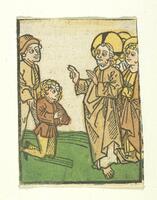
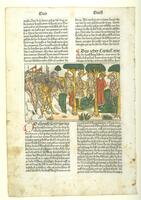
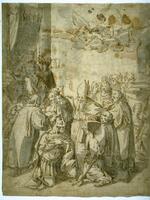
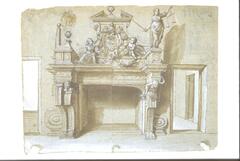

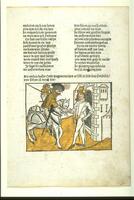
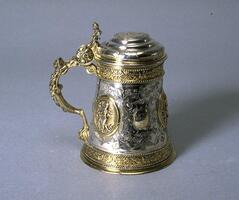
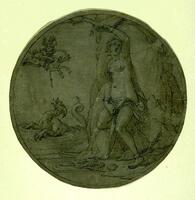

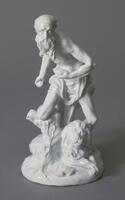
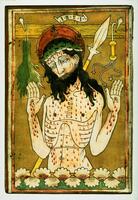
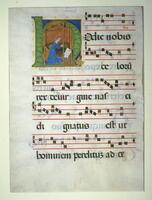

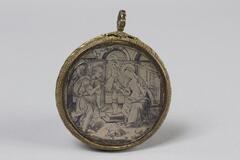




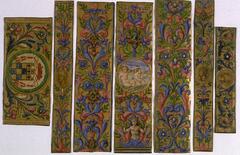
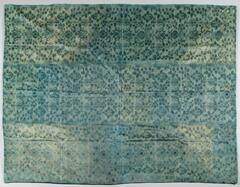
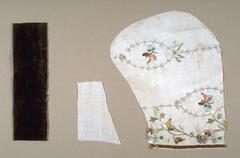
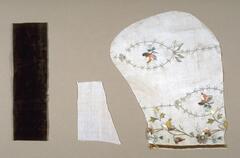
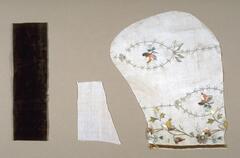
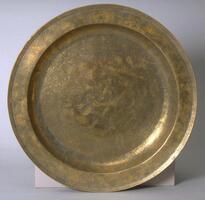
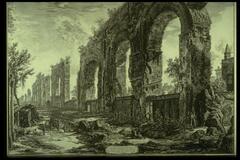

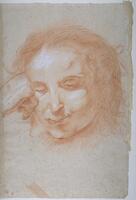
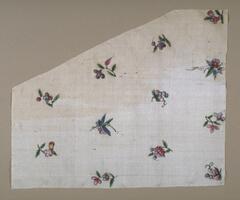


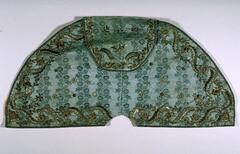
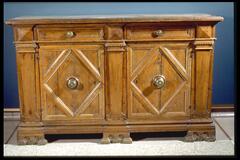

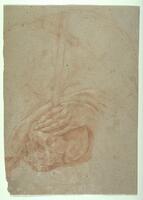

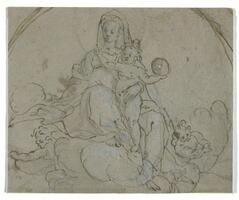
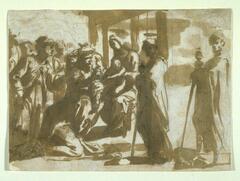
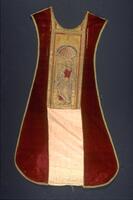
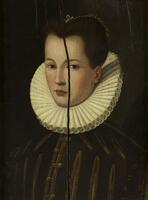

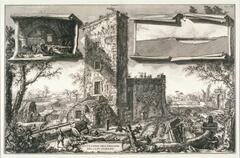


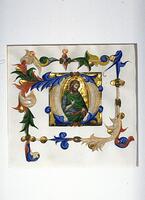
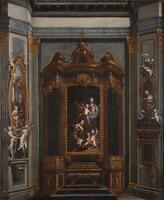
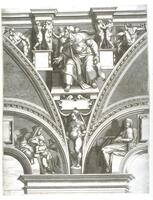
![This rectangular panel depicts four sacred figures rendered in dark hues with passages of vibrant red against a gold background. The upper edge of the gilded frame bears the prayer known as the "Hail Mary" ("Ave Maria Gratia Plena Domin[us tecum]"). This rectangular panel depicts four sacred figures rendered in dark hues with passages of vibrant red against a gold background. The upper edge of the gilded frame bears the prayer known as the "Hail Mary" ("Ave Maria Gratia Plena Domin[us tecum]").](/media/W1siZiIsIjIwMjIvMDUvMjUvMzZ5bWpwaTBuNl9kZWZhdWx0LmpwZyJdLFsicCIsInRodW1iIiwiMjQweDIwMCJdXQ?sha=182c62b7143d052b)
